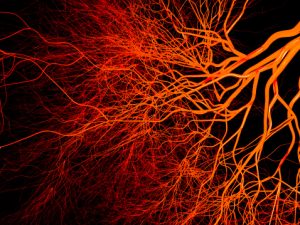 Vasospasm is a medical condition characterized by the gradual contraction of arteries that carry oxygenated blood. Abnormal contraction prevents normal blood flow affecting various parts of the body. A vasospasm definition will depend on the location it occurs in. For example, if it occurs in the brain, it will be referred to as a cerebral vasospasm, which can cause stroke-like symptoms.
Vasospasm is a medical condition characterized by the gradual contraction of arteries that carry oxygenated blood. Abnormal contraction prevents normal blood flow affecting various parts of the body. A vasospasm definition will depend on the location it occurs in. For example, if it occurs in the brain, it will be referred to as a cerebral vasospasm, which can cause stroke-like symptoms.
Vasospasm can cut off blood circulation leading to tissue ischemia and tissue death. Knowing what is vasospasm can help you recognized symptoms they may present with and seek out help when appropriate.
Types of vasospasm
Cerebral vasospasm
Advertisement
A phenomenon occurring due to narrowing of the large and medium-sized arteries found in the brain. They are more likely to occur after an aneurysmal subarachnoid hemorrhage, which is when bleeding occurs within the compartment surrounding the brain called the subarachnoid space. Unfortunately, the reasoning behind why cerebral vasospasm occurs is poorly understood. There is currently no single best treatment to help prevent cerebral vasospasm and the neurological complications it may cause.
Coronary artery vasospasm
Coronary arteries are the blood vessels that supply the heart with oxygenated blood. Coronary artery spasms are an important cause of chest pain syndrome that can lead to a heart attack (myocardial infarctions), ventricular arrhythmias, or even sudden death. This is because if the blood supply to the heart becomes compromised, like in cases of coronary artery spasm, the organ responsible for pumping blood throughout the body can become fatally damaged.
A well-known chest pain syndrome called Prinzmetal’s angina or variant angina is believed to be associated with coronary vasospasm. What is unique about this condition is, unlike other patients suffering from angina, Prinzmeal’s angina patients develop chest pain symptoms at rest, without performing any sort of exercise or increased cardiac workload.
Causes and symptoms of vasospasm
Blood vessels have varying degrees of contraction and relaxation controlled by endothelial cells, a type of cell that lines blood vessels. These cells release substances such as prostacyclin and nitric oxide that help induce blood vessel relaxation of smooth and inhibit the factors that lead to contraction.
It is believed that in cases of increased atherosclerosis, dysfunctional endothelium leads to the inhibition of prostacyclin and nitric oxide release on smooth muscle cells, promoting vasoconstriction.
Having suffered from a previous medical condition, such as a hemorrhagic stroke, is known to significantly increase the chances of developing cerebral vasospasm. Similarly, those suffering from atherosclerosis are expected to be at increased risk for developing coronary vasospasm.
Vasospasm symptoms will depend on the area affected by the constricted blood vessels with the most unwanted complications causing stroke-like or coronary artery associated symptoms. The following are the most common presentations depending on the location of vasospasm.
Cerebral vasospasm
- Weakness on one side of the body
- Confusion
- Difficulty speaking
- Vision problems
- Difficulty walking
- A severe headache of unknown cause
- Dizziness
Coronary artery vasospasm
- Chest pain
- Constricting, crushing, or squeezing pressure on the chest
- Shortness of breath
- Cold sweat
- Nausea
- Chest pain that may spread to the neck, jaw, or back
Diagnosing vasospasm
The diagnosis of vasospasm can be quite complicated, as the consequence of the condition may have already occurred. This leaves physicians only with symptoms left behind to base their diagnosis off of. It is estimated that between 2 to 10 percent of angina patients suffer from Pinzmetal’s angina, but the distinction is often overlooked by a cardiologist who stops testing protocol once a ruling of typical angina has been found.
Regardless of this fact, a complete physical examination, complete with a patient’s history of presenting symptoms will be taken. Additionally, the use of computed tomography (CT) or magnetic resonance imaging (MRI) angiography may be utilized to help observe blood flow through the affected blood vessel. Other tests that may be used include a transcranial doppler ultrasound to measure blood flow throughout the arteries of the base of the brain, and electrocardiogram (ECG), to evaluate the electrical activity of the heart
How to treat vasospasm?
Prevention is the best treatment of vasospasm and may include:
- Decreasing bad cholesterol (LDL) levels
- Quitting smoking
- Getting adequate amounts of physical activity
- Control medical condition such as diabetes or hypertension
Acute cases of vasospasm of the coronary arteries may be remedied using drugs that increase nitric oxide levels in the blood (nitroglycerine), causing vasodilation and allowing more coronary artery blood flow. Other medications that may be used to prevent coronary vasospasm include calcium channel blockers (ex. Verapamil) and beta-blockers (ex. Propranolol). Both medications help protect the heart by reducing oxygen demand.
Cerebral vasospasms treatment aims to first managing bleeding that occurs in the brain which will require emergency care performing interventional radiology and/or neurosurgery. Stroke prevention management may also be implemented.
Advertisement
Related:
Essential oils for circulation: 10 best oils to improve blood circulation
Causes of Circulatory System Diseases
